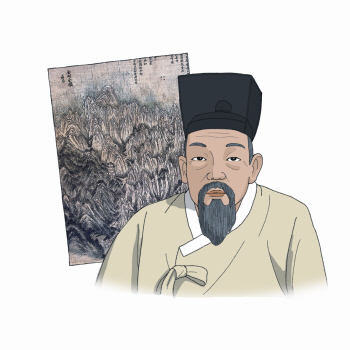Great People of Korea (1)
 1. Dae Jo-Young (?– 719, reign: 698 – 719)
1. Dae Jo-Young (?– 719, reign: 698 – 719)
Dae Jo-Young was the founder of the Balhae kingdom. After the fall of the Goguryeo kingdom, he gathered the refugees and some Malgal tribes and established Balhae. Upon its founding in 698, he proclaimed that it was the successor of Goguryeo, both domestically and internationally, and began to regain control over former Goguryeo territories. His posthumous epithet “King Go” indicates that he succeeded the Goguryo kingdom and became the founder of a new kingdom.
 2. King Gwanggaeto the Great (374 – 413)
2. King Gwanggaeto the Great (374 – 413)
King Gwanggaeto was Goguryeo kingdom’s nineteenth king, who achieved political supremacy in 5th century Northeast Asia. He used the name of his own reign for the first time in Korean history, and established a great empire that occupied the present-day Liaodong peninsula and a part of Inner Mongolia. A tombstone was built in honor of his distinguished achievements, and it still remains in Jian, China.
 3. Lee Je-Ma (1838 – 1900)
3. Lee Je-Ma (1838 – 1900)
Lee Je-Ma was a physician who created a unique Korean medical theory called “Sasang Uihak.” This theory is based on Eastern philosophy, and its basic principle is that treatments should vary, depending on a patient’s particular constitution. He spent his entire life studying medicine, and established his own medical theory based on extensive clinical data.
 4. Seo Hui (942 – 998)
4. Seo Hui (942 – 998)
Seo Hui was a diplomat of the Goryeo dynasty. He is best known for his role in a negotiation in 993 where he persuaded the invading Khitan army to retreat by arguing for the legitimacy of Goryeo as the successor of the Goguryeo kingdom. Through the negotiation, he also regained control over the Pyeonganbukdo area. For this reason, his actions are regarded as the most successful example of diplomacy in Korean history.
 5. Dangun
5. Dangun
Dangun was the founder of the first Korean kingdom of Gojoseon in 2333 BC. Korea’s first history book about its ancient kingdoms, Samguk Yusa, contains a story about his founding of the nation and his basic principle of Hongik Ingan. The principle means to promote the benefit of humanity, and it forms the basis of the strong Korean national identity that has functioned to unite Koreans on occasions of national crisis.
 6. Jeong Seon (1676 – 1759)
6. Jeong Seon (1676 – 1759)
Jeong Seon was a painter who developed a unique Korean style of landscape painting during the late Joseon dynasty. He portrayed Joseon’s scenery with his own creative touches, breaking off from the strong influence of China. His major painting “Geumgang Jeondo” provided great inspiration for other painters in their drawings of Mt. Geumgangsan.
 7. Kim Jeong-Ho (? – 1866)
7. Kim Jeong-Ho (? – 1866)
Kim Jeong-Ho was a geographer who made many maps during the late Joseon dynasty. Daedongyeojido in particular is a masterpiece that he created by integrating Eastern cartographic traditions. The map is very accurate and precise, even compared to contemporary maps. He also compiled geographic books that showed changes in administration, transportation and historical geography, which contributed to a better understanding of maps.










 Copyright @ 1999-2012 VANK. All rights reserved.
Copyright @ 1999-2012 VANK. All rights reserved.
You must be logged in to post a comment Login